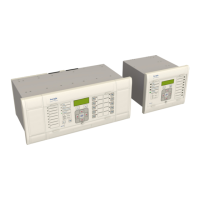5.2.6.2 CT REQUIREMENTS - ONE-AND-A-HALF BREAKER APPLICATION
According to the test results, to achieve through-fault stability, the K dimensioning factor must comply with the
following:
System Conditions K Kneepoint voltage (VK)
2I
n
< I
F
£ 64I
n
5 £ X/R £ 20
27
V
K
³ 27I
n
(R
CT
+ 2R
L
+ R
r
)
where:
● V
K
= kneepoint v
oltage
● K = CT dimensioning factor
● I
n
= rated current
● R
CT
= resistance of CT secondary winding
● R
L
= Resistance of a single lead from device to current transformer
● R
r
= resistance of any other protection devices sharing the current transformer
To ensure through-fault stability is achieved, the following ratios: should not exceed a maximum disparity of 4:1
V
K-HV
/ R
tot-HV
: V
K-TN1
/ R
tot-TN1
V
K-LV
/ R
tot-LV
: V
K-TN2
/ R
tot-TN2
V
K-TV
/ R
tot-TV
: V
K-TN3
/ R
tot-TN3
where:
● V
K-HV
= Kneepoint voltage of CT at HV side
● R
tot-HV
= Total burden connected to CT at HV side
● V
K-LV
= Kneepoint voltage of CT at LV side
● R
tot-LV
= Total burden connected to CT at LV side
● V
K-TV
= Kneepoint voltage of CT at TV side
● R
tot-TV
= Total burden connected to CT at TV side
● V
K-TN1
= Kneepoint voltage of TN1 CT
● R
tot-TN1
= Total burden connected to TN1 CT
● V
K-TN2
= Kneepoint voltage of TN2 CT
● R
tot-TN2
= Total burden connected to TN2 CT
● V
K-TN3
= Kneepoint voltage of TN3 CT
● R
tot-TN3
= Total burden connected to TN3 CT
This ensures that during a through-fault condition, the flux density in the CTs is not greatly different.
5.3 HIGH IMPEDANCE REF PROTECTION APPLICATION
5.3.1 HIGH IMPEDANCE REF OPERATING MODES
In the examples below, the respective Line CTS and measurement CTs must have the same CT ratios and similar
magnetising characteristics.
P64x Chapter 8 - Restricted Earth Fault Protection
P64x-TM-EN-1.3 183

